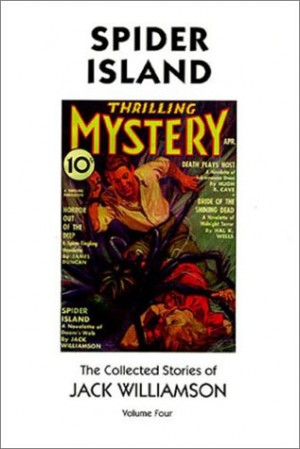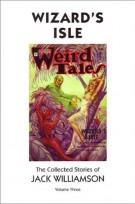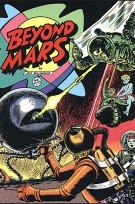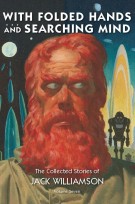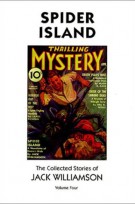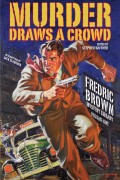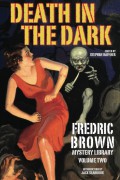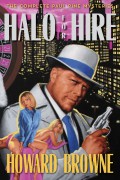Spider Island, The Collected Stories of Jack Williamson, Volume Four
Introduction by Edward R. Bryant
Cover Art by Rudolph Belarski
ISBN-13 9781893887145
616-page Hardcover
PRICE INCLUDES $5.00 USD for USPS Media Mail Shipping
This fourth volume continues the publishing program to collect the stories of Science Fiction Grand Master Jack Williamson.
Drawn from such classic pulp magazines as Astounding Stories, Weird Tales, Thrilling Wonder Stories, and Thrilling Mystery, this volume features sixteen tales (including four novel-length adventures, “Dreadful Sleep,” “The Blue Spot,” “Released Entropy,” and the original magazine text of The Legion of Time), seven of which have never been published in book form.
The book is smythe-sewn, bound in full cloth, and printed on acid-neutral paper, with full-color endpapers reproducing the original pulp magazine cover art.
With a foreword by author, and critic, Edward Bryant, Spider Island contains the sense of wonder from the early years of American Science Fiction and continues the documentation of Williamson’s unparalleled career.
"American Gods, American Dreaming" by Edward Bryant
"The Ruler of Fate" (Weird Tales, Apr, May, Jun '36)
"Death’s Cold Daughter" (Thrilling Mystery, Sep '36)
"The Great Illusion" (with Eando Binder, Edmond Hamilton, Raymond Z. Gallun, and John Russell Fearn) (Fantasy Magazine, Sep '36)
"The Blue Spot" (Astounding Stories, Jan & Feb '37)
"The Ice Entity" (Thrilling Wonder Stories, Feb '37)
"Spider Island" (Thrilling Mystery, Apr '37)
"The Mark of the Monster" (Weird Tales, May '37)
"The Devil in Steel" (Thrilling Mystery, Jul '37)
"Released Entropy" (Astounding Stories, Aug, Sep '37)
"Dreadful Sleep" (Weird Tales, Mar, Apr, May '38)
"The Infinite Enemy" (Thrilling Wonder Stories, Apr '38)
"The Legion of Time" (Astounding Stories, May, Jun, Jul '38)
Afterword" by Jack Williamson
Appendix
"Interview with Jack Williamson" (Interview, The Science Fiction Fan, July 1936)
"Psychology and Characterization" (Article, Science Fiction Correspondent, November/December 1936)
"Has Science Fiction a Future?" (Article, The International Observer, January 1937)
"Polar Catastrophe" (Authorial Comments on “The Ice Entity," Thrilling Wonder Stories, February 1937)
"Science in Science-Fiction" (Letter to the editor, Astounding Science Fiction, June 1937)
"Horror Yarns—Double Action" (Article, The Author & Journalist, August 1937)
"The Inverse Universe" (Authorial Comments on "The Infinite Enemy," Thrilling Wonder Stories, April 1938)
“. . . Let me phrase my sentiments bluntly: Stephen Haffner's as-yet-uncompleted achievement in resurrecting all of Jack Williamson's short fiction is as good as publishing gets. Note that I did not say "as good as small press publishing gets," but as good as any publishing program gets. Big house or small, no one else in recent memory has lavished any greater love, attention, historical respect or keen design sensibilities on such a project . . . From the moment you open this book and see the gorgeous endpapers, which colorfully reproduce all the pulp 'zine covers first associated with these stories, you will be impressed by the craftsmanship and quality materials that underpin each book. For the price, there's not a better deal for either the hardcore collector or unassuming reader. And a feature such as the non-fiction appendices illustrates how Haffner has gone the extra mile to unearth material that would otherwise be lost.
But of course, without Williamson and his marvelous work, all this labor and craft would be pointless. It's the chance to read these mostly forgotten (and sometimes much-anthologized) stories from the early years that gets the SF neurons firing. These stories appeared from April 1936 to July 1938, the very cusp of the John W. Campbell era (JWC took over the helm of Astounding in September 1937). And what they tell us about the young Williamson himself and the genre at the time is plenty . . . "The Ruler of Fate" predicts the famed Butterfly Effect and rewrites all of Earth's history as the whim of a tyrant. With its self-organizing life form, "The Ice Entity" appears to be based on the field of artificial life some decades before that field was invented. And "The Blue Spot" anticipates Greg Egan with its conundrums deriving from downloaded personalities. But the top three stories exceed all expectations. "Released Entropy" barrels like an express train through the Big Crunch and beyond, as if written by van Vogt and Poul Anderson. "Dreadful Sleep" outdoes both Lovecraft and M.P. Shiel in its portrayal of cosmic menace. And "The Legion of Time" is tinged with Moorcock's blithe multiversal buccaneering. If Williamson had written nothing else but this trio, he'd have earned his place in SF's pantheon.
And what do the stories tell us of the 30-year-old author? They convey a sense of someone self-assured and worldly, with a prose style fluid and mutable, equipped to handle any task he set himself. Having just at this time undergone some initial psychoanalysis, Williamson's fertile invention was now tapping into subconscious realms that allowed him to portray Oedipal and male-female conflicts in vivid narrative shapes. Why have these stories survived when others of their vintage have disappeared? They continue to grip us because Williamson wrote not solely for money but for love of his art, and listened to his soul."
—Paul di Filippo, Science Fiction Weekly
